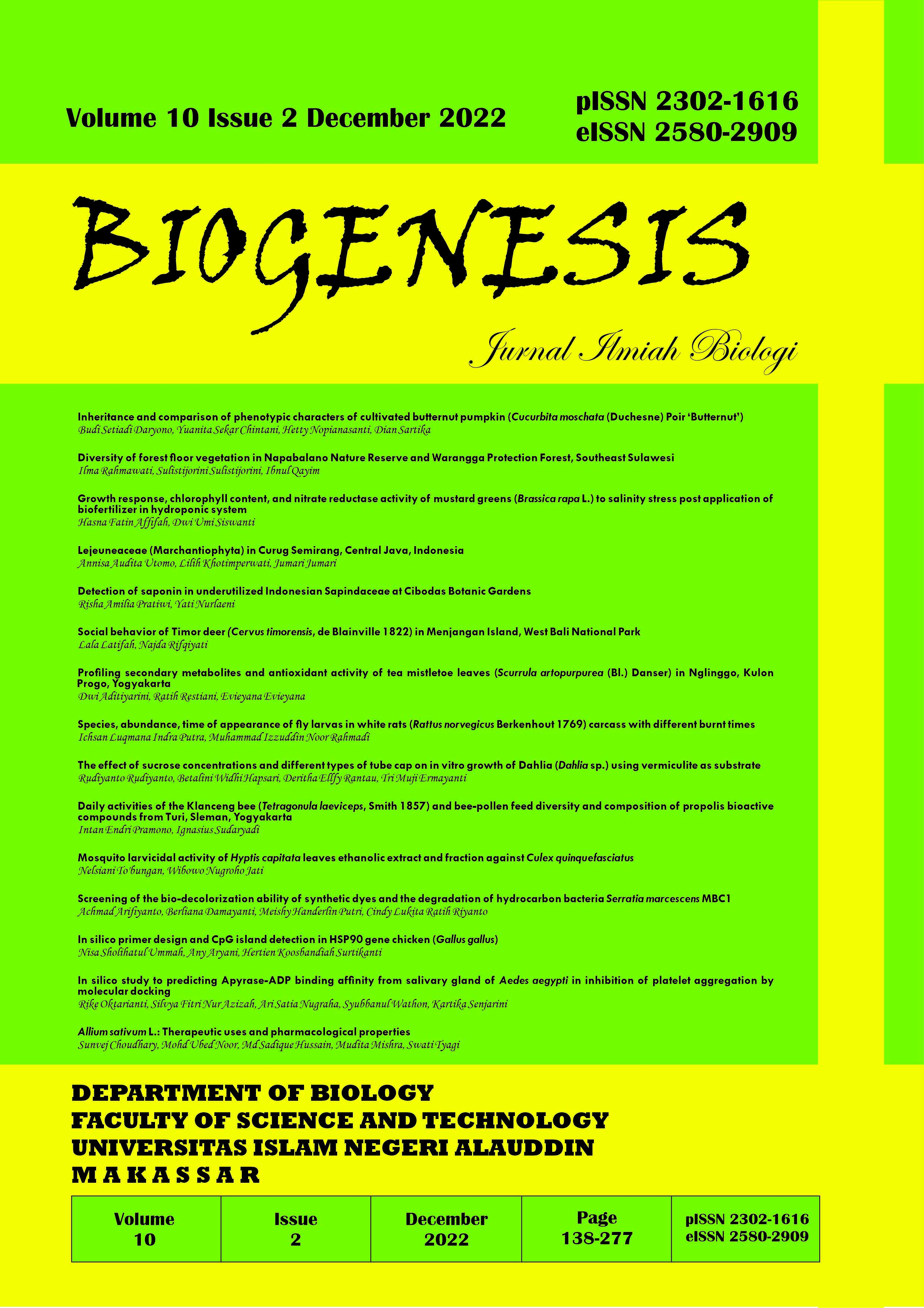Mosquito larvicidal activity of Hyptis capitata leaves ethanolic extract and fraction against Culex quinquefasciatus
Abstract
Larvicidal potential of Hyptis capitata grown in Indonesia has not been extensively studied. Its leaves are extracted with the maceration method using ethanol as the solvent. Furthermore, this study aims to use the ethanolic leaf extract of the H. capitata for larvicidal assays against instar III/IV larvae of Culex quinquefasciatus with different concentrations, including 1000, 500, 250, 125, and 62.5 µg/mL. Fractionation of the extract was carried out by vacuum liquid chromatography, and obtained four fractions, namely fractions F1, F2, F3, F4. Fractions were also used for the larvicidal assay. The constituents of the extract were then analyzed with the GC-MS method to predict the components involved in its toxicity. Larvicidal data obtained were analyzed using regression analysis to determine the LC50 value. Analysis of variance was carried out with one-way ANOVA using Tuckey HSD-test on the SPSS ver. 26 at 95% confidence and significance P<0.05. H. capitata ethanolic leaf extract has a higher level of toxicity than its fraction, with LC50 value 990.90 µg/mL. H. capitata ethanolic leaf extract are capable of providing a toxic effect on larvae, with a mortality percentage of up to 50% more. Some compounds that were assumed to play a role in its toxicity include pentadecanoic acid, 2,6,10,14-tetramethyl-, methyl ester; 1-heptadecyne; 9-tetradecen-1-ol, acetate; oxyrane, deodecyl-; 9,12,15-octadecatrienal; and 6,11-dimethyl-2,6,10-dodecatrien-1-ol. These finding indicate that the ethanolic leaf extract of H. capitata has the potential to be developed as a biolarvicidal agent against C. quinquefasciatus.
Copyright (c) 2022 Nelsiani To'bungan, Wibowo Nugroho Jati

This work is licensed under a Creative Commons Attribution 4.0 International License.
COPYRIGHT AND LICENSE STATEMENT
COPYRIGHT
Biogenesis: Jurnal Ilmiah Biologi is published under the terms of the Creative Commons Attribution license. Authors hold the copyright and retain publishing rights without restriction to their work. Users may read, download, copy, distribute, and print the work in any medium, provided the original work is properly cited.
LICENSE TO PUBLISH
1. License
The use of the article will be governed by the Creative Commons Attribution license as currently displayed on http://creativecommons.org/licenses/by/4.0.
2. Author’s Warranties
The author warrants that the article is original, written by stated author/s, has not been published before, contains no unlawful statements, does not infringe the rights of others, is subject to copyright that is vested exclusively in the author and free of any third party rights, and that any necessary written permissions to quote from other sources have been obtained by the author(s).
3. User Rights
Under the Creative Commons Attribution license, the users are free to download, reuse, reprint, modify, distribute and/or copy the content for any purpose, even commercially, as long as the original authors and source are cited. No permission is required from the authors or the publishers.
4. Co-Authorship
If the article was prepared jointly with other authors, the corresponding author warrants that he/she has been authorized by all co-authors, and agrees to inform his/her co-authors of the terms of this statement.
5. Miscellaneous
Biogenesis: Jurnal Ilmiah Biologi may conform the article to a style of punctuation, spelling, capitalization, and usage that it deems appropriate. The author acknowledges that the article may be published so that it will be publicly accessible and such access will be free of charge for the readers.


